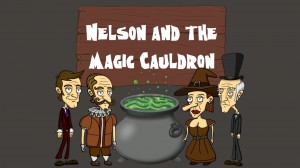Review for Harvester of Dreams: Episode 1

Taking nearly seven years to produce, the debut installment of the free-roaming 3D adventure Harvester of Dreams is clearly a labour of love for its solo developer Christian Waadt. Described as a game in which you must differentiate dream from reality, Episode 1 provides intriguing hints into this duality from the start of your experience as the sole passenger aboard the Tuna Airship. The time spent on this steampunk-inspired dirigible is entertaining and features some intriguing mechanics, although the later portion of the game, after disembarking, is not nearly so enchanting.
Players take on the role of an unseen, unnamed protagonist who nevertheless possesses a male voice and makes occasional comments on the sights he sees and the challenges he encounters. As the game opens, our hero is questioning his recurring presence on the airship he remembers little about, while a foreboding subtitle appears on the screen: Night 156.
Gameplay commences on the bridge. A gleaming pilot’s chair looks out through a domed glass window at fluffy white clouds drifting by. The man claims to not be a pilot, but that’s unimportant as the ship is apparently flying itself. The first goal: to get through a locked door to explore the rest of the vessel. In fact, a fair few number of tasks here involve getting through locked doors via different means, whether as simply as oiling rusty hinges or somewhat more complex solutions like using navigational directions to operate a keypad.
Many of the challenges are of the straightforward inventory variety. Items that can be taken glow blue as you draw near, in contrast to hotspots that can be interacted with, which glow green. The inventory can be accessed with a quick keystroke and overlays the screen. Clicking an item there will attempt to use it on the currently highlighted hotspot. Harvester of Dreams plays in typical first-person fashion, with the mouse and WASD (or arrow) keys used for general movement. Gamepads are also at least partially supported, although mine fell outside of the partial category as I was not able to get it to work. Regardless of your control method, don’t confine your thinking to simple two-dimensional movement in this game. Several key areas require looking up or down or even behind objects.
In situations where finer control is needed, such as manipulating closely placed buttons on a keypad, a special locked camera mode can be toggled. In this state, the otherwise fixed targeting reticle can be moved around the screen in 2D point-and-click fashion. The mix of control schemes and ease of toggling between them works extremely well and I very much appreciated the attention paid to user-friendliness in this important aspect of the experience.
While most of the puzzles are inventory-based, there are a number that distinguish themselves by taking advantage of the 3D environment. One such challenge is reminiscent of assorted children’s toys where the goal is to navigate a metal ball to a specific hole in a maze by tipping the puzzle this way and that. The mechanism here is much too large to fit in the palm of your hand, but it follows the same basic principle, with input controls used to tip a metal plate this way and that to balance the ball to its final destination. Care was obviously given to this scenario as well, as it could easily have felt cumbersome and ungainly but actually works extremely well.
In another instance, a silver tray must be positioned in a corridor and a special console manipulated to maneuver a beam of light around a corner and down a hallway from one end to the other to hit a specific target. Here again, the player experience has been taken into consideration as a picture-in-picture camera frame is provided to show where the distant target is and allow for fine adjustment of the light beam in order to hit it.
The cleverest puzzle, however, is one that refers back to that early foreboding message of Night 156 (this number is actually variable for each game, but always high). While exploring the ship, you will find your way into the airfoil, where a couple of valve wheels are presented for filling the balloon or releasing pressure. Without giving the solution away, it’s necessary to manipulate these controls to access a much needed item. The only problem is that in so doing, the balloon’s flight becomes unstable and the blimp crashes. Inexplicably, during the crash you will be relocated to a mountaintop to watch the Tuna go down in a smoking ruin. Then you’re returned, on Night 157, to the inside of the airship again.
This is not simply a matter of dying and then being placed back at the start of the sequence to try again. Instead, if you acted in time and collected the needed item before the crash, you’ll still have it. If not, you’ll have to try the controls again. This is one of the many hints that reality aboard this unique craft doesn’t quite operate the way one would normally expect. It’s a bit of a shame that this technique – of dying in order to progress further – isn’t used more often throughout the game, as it’s definitely a standout.
Despite the sometimes cramped confines of the airship, there are quite a number of different looks on display. The passenger sections are cozy, with richly patterned wallpaper and wood and brass fittings. The crew areas tend to be more strictly industrial, with exposed piping, large cogwheels, and grease stains. Although the ship may be abandoned, signs abound that those other 155 nights spent aboard weren’t always peaceful. In one cabin, a broken mirror is found with blood on the frame and floor. Another location features a body that seems to have almost been wired into the ship itself. These mysterious tableaux do a good job of raising intrigue about what exactly is happening here.
On the audio front, Harvester of Dreams complements its steampunk aesthetic with appropriate sound effects. Doors whoosh open with a pneumatic hiss, mechanical equipment makes suitably metallic sounds, and so on. The game has no ambient music, although the occasional easy listening tune can be played, such as when using a phonograph found in one of the cabins. In a nice touch, the needle actually moves across the record while playing. The main voice throughout is that of the nameless hero, but later on a female voice from an unseen source is encountered, and both are well done.
In the latter part of the game, you will eventually disembark the Tuna and make your way into an underground bunker. I must confess that I found this segment to be underwhelming. Gone is the interesting steampunk backdrop of the airship, with its lush colours and unusual mechanical devices. In its place you will find a structure made up of grey slabs of concrete and repetitive hallways and floor design. The whole setting feels much less polished than earlier in the game.
The gameplay suffers here too. While there are still one or two mental challenges to overcome, when you leave the Tuna you get an odd revolver with multiple bullet chambers that circulate in and out as you shoot. This becomes the main way of expressing your intent as you move through the bunker. There are no guards per se, but turrets descend from ceilings and mechanical bots are occasionally on patrol, which must be shot in order to proceed. For those leery of any sort of action, there’s no fear here as plenty of cover is provided in this concrete jungle and the turrets do not fire at all quickly, allowing for a simple step from cover and pull of the trigger (or click of the mouse) to dispatch the threat. It’s very easy, but also very tedious and was a disappointment to me after some of the clever obstacles aboard the airship.
During the climax, which I reached in under two hours of play time, the nature of the dichotomy between dreams and reality is eventually revealed, but it’s done rather abruptly and with too many loose threads left dangling to feel satisfying as a standalone game. This debut episode is very much a case of anticipation being more enjoyable than the actual reveal. However, the events at the end clearly set up the potential for more intrigue to come, teasing new locales to visit in the future, including the pyramids.
Harvester of Dreams: Episode 1 spends most of its time aboard the zeppelin, which turns out to be a very good thing. With its varied interiors, lush palette and clever use of 3D space, it’s a fun place to roam around in while searching for clues to the broader mystery of what’s going on. Though the eventual land section and ultimate revelations are a bit underwhelming, the steampunk section comprises the majority of the experience and is strong enough to overshadow the letdowns. Even though it took seven years to get this first installment, I for one hope Mr. Waadt is able to deliver another down the road (or up in the sky as the case may be). It’s not completely turbulence-free, but the brief flight of the Tuna Airship is smooth enough to warrant a look between lengthier adventures.



























